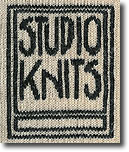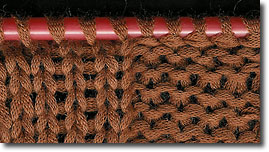 |




Welcome to StudioKnits.com©
Original knitting patterns, delivered instantly to your computer!
------------------------------------------------------
Online knitting book
»
Join news list
| Contact |
FAQ - About us
Home (Patterns)
How to Become an "Expert
Knitter"
*Buy this book
on CD for offline reading!
table of contents
»
epilogue
How I Became an
"Expert Knitter"
Thanks to my mother, as a young child, I learned how to knit
stitches and then (no) thanks to a ho-hum craft teacher, I tried to
knit things. Each child in the class had to knit a face washer. We
had face washers at home. Matched to our towels.
I decided to make a jumper. Hectic green yarn, cables trimmed with
knitted-in cherries, bright red, and pine green leaves. This was the
only time I ever tried to follow a pattern. Very soon, the teacher
avoided looking in my direction. I struggled through the whole term
and got as far as the armholes. I think my mother eventually threw
it into the bin. I know I never wanted to see it again.
The next inspiration was an advertisement in an American magazine.
Part of it was a photograph of a bit of knitting, cream, with the
head of Mickey Mouse worked in three colours. Well, I thought it was
wonderful! I was going to make a jumper (that’s what we called them,
then), and finish it, and wear it, and show everyone that I was a
wonderful knitter. I gazed and gazed at the ad, working out where to
put the stitches and colours. I knitted tiny stitches and so tightly
that I could hardly get the needle through ready for the next
stitch. When I gave that up as a bad job, I thought that was it with
knitting.
I got stuck into sewing. My mother had a Singer sewing machine, my
father was a clothing manufacturer, I always had access to fabric,
so making my own clothes was natural. Whenever an “occasion” like a
family wedding, a religious holiday, a party or a very important
date was heralded, the first thing I had to organise was… WHAT TO
WEAR!!!
It was obvious where my interests were. I wandered around fabric
shops and mooned over button displays. I devoured fashion magazines.
My French teacher loved me. I was so diligent. The high marks
weren’t the primary reason for my interest in her lessons. I wanted
to understand the captions in French Vogue magazines.
When I left school, I dived into a year-long flirtation with the
denizens of the graphic design and advertising department of the
main technical college in Melbourne, of course, wearing all my own
creations. On holiday in Sydney, I was pestered on the beaches by
women asking where I bought my swimwear. I had made it myself. I
quickly saw that I had to change my direction, so I stopped all the
art stuff and switched to dress design.
I started haunting wholesalers in Flinder’s Lane, the rag trade area
of Melbourne, looking for zips and fabrics and buttons and trims. I
found a box of reels of something called mohair. I had never come
across it before and in fact, mohair only appeared in knitting shops
five or six years later, in a completely different form. Smoky grey
blue, very fine and a bit furry, I didn’t know what it should have
been for, but I decided to buy the whole box. I knitted with three
reels wound together and made a V neck sweater. I only had enough
yarn to make the shape, and the sleeves had to be shorter than I had
intended, so I edged it with matching gros-grain ribbon. I was all
of seventeen, but I felt very adult when I wore it. I felt chic. My
mother thought the hairy mohair was awful and the ribbon edge just
plain wrong, but this was my first finished thing, and I nearly wore
it flat.
That was that for a while. No more knitting. The closest I came to
needles was a strange but very influential event. I had been given a
cashmere twinset. A friend’s mother decided that the colour, olive
green, wasn’t good for her very tanned skin, and I was in the right
place at the right time. It was a treasure. Thick, soft, silky
cashmere, in fact unusually thick, and with stitches about the same
size as if the garment had been hand-knitted. I eventually had to
wash the two pieces after constant wear and I hung them sideways
over a towel on the line to dry. My beloved labrador dog, Animal,
thought I had given him a new toy, and when I went to check on the
drying, I found he had shredded all four sleeves. What fun.
In tears, I decided to unpick what remained of the tops of the
sleeves, make the sweater into a sleeveless sweater and try to
re-knit the cardigan sleeves with whatever yarn I could salvage. As
I unpicked, I counted the stitches and made notes. That introduced
me to the shaping at the top of the sleeves, and I realised exactly
how all that worked. The important bit was the position of the
shaping. Not on the edge, but a few stitches in on each side, so
that the seam would be on a straight line. I was terrific at
starting things, but with all my other distractions, like life, I
wasn’t great at finishing projects. The sleeveless twinset and the
two balls of wound–up cashmere hung around for ages, but they had
done their work. I would make good use of the experience in the
future.
Selling painted cards to make extra summer vacation money, I met a
genius, a wonderful woman, who owned a shop packed with incredible
homewares and a huge home workroom. She asked me to work for her. I
was sick to death of being a student. I hated the slow pace as the
less involved held back the rest of the class. One girl took three
terms to construct a horrible, amateurish camel-hair coat. Who would
have employed her? I jumped at the chance of practical, yet creative
work and left the tech school. I beavered away day and night,
painting designs, gluing things on things, decorating boxes,
applying vivid lacquer stripes on to sprayed white bottles and vases
on a whizzing pottery wheel, colour, style design, never the same
thing twice. If I could have slept there, I would have, but it was
too intense to last.
I spotted an ad for a position as the display artist at one of the
most beautiful and elegant department stores in the world. “Georges
of Collins Street” in Melbourne. I was amazed and thrilled when my
application was successful. What I did could not be described as
work. I played every day with the most fantastic merchandise. I
examined the secrets of building couture garments, admired the
perfection and revelled in the glory of extravagant luxury clothing,
exquisite accessories and inspired homewares. The brilliant people I
worked with, and the generous display budget allowed me to devise
dream displays. All the techniques I had learned at art school came
in for a showing. I painted, and modelled, and arranged, and sewed,
and glued to my heart’s content. I bought heaps of the marvellous
clothes in the store, but still liked to make and wear my own.
NEXT
PAGE >> chapter
page: 1 | 2 |
3 |
|